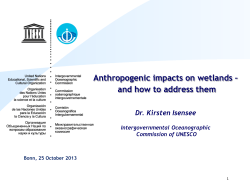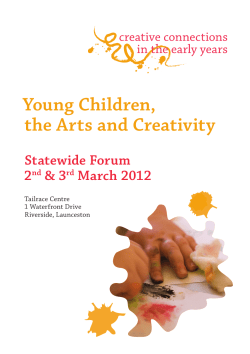
Adapting to Climate Change – what is government doing?
Adapting to Climate Change – what is government doing? The purpose of this paper is to provide some background to participants attending the Climate Change Adaptation and Planning forums being held in Tasmania from 20 to 23 April 2010. The paper provides a brief overview of what the various levels of Government are doing to assist Australians adapt to the impacts of climate change and provides some detail on the issues Local Government has to consider in planning for climate change impacts. The aim of the forums is to provide councils with an update on many state led projects that have been developed to assist Local Government in adapting to climate change. The forums will also provide an opportunity to collectively determine the key needs of councils in adapting to climate change and to explore potential opportunities for leveraging assistance in meeting these needs. In particular the Association seeks to understand what targeted assistance it might provide to councils in meeting these needs as well and to inform the strong negotiation of good outcomes for Local Government in any future partnership agreement with the State Government. Background Tasmania’s climate is changing in ways that will influence the roles and responsibilities of Local Government. The expected increase in climate variability and extreme weather is a real concern. This change will result in impacts such as more severe droughts, increased fire danger, increased floods, erosion and landslides, increased storm surges as well as coastal inundation. This change will affect small and large, and rural and urban councils, and will have effects on land use planning, infrastructure, emergency preparedness, community services, and resource management. Over the last decade Local Government has been at the forefront of climate change mitigation strategies. Much of the focus has been on reducing greenhouse gas emissions associated with buildings, street lighting, waste, transport and through the adoption of renewable energy sources. However there is increasing acceptance that the impacts of climate change are already being felt and although mitigation efforts may lesson these impacts further change is inevitable and all levels of government need to adapt. National Focus on Adaptation This shift in focus to adaptation is also happening at the National level with the Commonwealth Government broadening its focus on mitigation strategies such as the carbon pollution reduction scheme to include approaches on adaptation. In February 2010, the Australian Government released the position paper, Adapting to Climate Change in Australia, which sets out a proposed approach to develop a national adaptation agenda to adapt to the impact of climate change though the Council of Australian Governments (COAG). The position paper recognises the need to establish roles and responsibilities for the different levels of government. The Australian Government will take a leadership role in positioning Australia to adapt to climate change impacts that may affect national prosperity and security. This will include: • • • Maintaining a strong, flexible economy and a social safety net; Leading national reform; Managing Commonwealth assets and programs; and • Coordinating national science and information. Climate Change Adaptation is not only high on the agenda at COAG but also the Local Government and Planning Ministers’ Council. The Commonwealth has convened the Senior Officials Group on Climate Change and Adaptation to progress a COAG work plan on climate change adaptation. The group has agreed to develop a draft 2010/2011 work plan which will delineate the roles and responsibilities for climate change adaptation between the Commonwealth, State, Territory and Local Governments and the private sector. The group will also pursue a nationally consistent approach to managing the vulnerability of the coastal zone to climate change impacts and identify other priority sectors for national adaptation collaboration. The Local Government and Planning Ministers’ Council has also endorsed the development of a National framework and tools for use by Local Government to inform planning for climate change mitigation and adaptation. It is likely that a draft discussion paper on the framework will be considered by the Council in late 2010. Further information on the position paper and other Australian Government reports, studies and tools are included at Attachment C. State Focus on Adaptation The Tasmanian Government established adaptation as one of the four objectives of the Tasmanian Framework for Action on Climate Change - specifically ‘adapting to the changes in our climate that are occurring now, and will continue to occur’. The Tasmanian Climate Change Office, in the Department of Premier and Cabinet, has a role in coordinating the Tasmanian Government’s efforts to assist Tasmanians adapt to the impacts of climate change. The initial focus of adapting to climate change has been on the following areas: 1. Ensuring scientific research gives us a firm foundation for taking action in different regions and different sectors by measuring and predicting climate change and identifying new approaches; 2. Giving individuals, communities and businesses appropriate information, resources, skills and incentives to plan and adapt to climate change and manage their own risks; 3. Providing an adequate and appropriate emergency response to more frequent and intense events, such as bushfires, floods and storms, and assisting communities recover from such events; and 4. Managing risks to public infrastructure, assets and values (including roads, biodiversity, national parks and reserves), and protecting industry and the community against health and bio-security risks. In order to learn more about how climate variables such as increased land and sea temperatures, changes to rainfall patterns and higher evaporation in most areas, wind speed changes, and sea level rises will impact on Tasmania, the Tasmanian Government, in partnership with the Antarctic Climate and Ecosystems Cooperative Research Centre, Australian Government and Hydro Tasmania, is funding the Climate Futures for Tasmania Project. Further information on the Climate Futures for Tasmania Project and other adaptation related projects, initiatives and tools developed by the Tasmanian Government is included at Attachment D. Local Government focus on adaptation Local Governments will need to be able to identify, understand and respond to the impacts of climate change. This response is likely to be complex and require a multi-faceted approach including: • • • • • • • land use planning; corporate planning; assessments of essential infrastructure location; policy development; infrastructure design and building guidelines changes; development of new local regulations; and building community awareness and initiating behavioural changes. Attachment A provides a summary of the likely impacts of climate change on a wide range of Local Government services. Nationally, the Australian Local Government Association (ALGA) has identified climate change adaptation as one of seven priority areas for 2010. In particular ALGA will be focussing on the following key actions at the national level: • • • to enhance the capacity of Local Government to adapt to climate change impacts by advocating for the establishment of a Local Government Climate Change fund; advocate for certainty in relation to litigation resulting from climate change particularly in coastal areas; and advocate for improved collaboration between the three levels of government on climate change issues. Attachment B provides a summary of some of the climate change adaptation projects being undertaken by other Local Government Associations around Australia. To date in Tasmania much of the climate change focus of councils has been on mitigation. Many councils have demonstrated a strong commitment to proactively reduce their carbon emissions through programs such as the CCP program. More recently, through the partnership agreement with the State Government all councils have committed to reducing their carbon emissions with assistance from Planet Footprint. The first climate change partnership agreement between Local Government and the State Government had a focus on measuring and reducing local government carbon emissions. This agreement expires in June 2010 and it is likely that a new partnership agreement will be entered into. It is probable that the focus of this agreement will be climate change adaptation. Key areas of need that have been identified broadly by Local Government nationally and worth considering prior to the forum include: • • • • • • • The need for specialist localised information on effects, impacts and responses. Research and leadership from government on legal issues in particular in relation to local authorities acting or not acting in terms of climate change adaptation. The lack of State Government policies providing clear and consistent planning guidance in relation to climate change. The lack of support to prioritise actions and expenditure in response to risk factors, in the context of limited incomes and many unknown specific impacts. Consistency between policies of different departments within a jurisdiction. The expectation from other levels of government that councils play a major role in communicating with local communities and promoting behaviour change without financial support or tools and templates from state and federal government. The lack of federal programs to support councils in adapting to climate change. • Councils’ capacity and capability to respond and plan for climate change, particularly regional councils that have limited income. ATTACHMENT A Planning policy and development assessment • • • • • • • Inappropriate location of urban expansion areas. Increased uncertainty in long-term land-use planning and infrastructure design, i.e. location of future developments, suitability of infrastructure designs to cope with changing climate, etc. Loss of private property and community assets. Increase in insurance costs and public liability claims. Increased pressure on disaster management and response resources. Early retirement of capital infrastructure. Cost of retrofitting of systems. Litigation Legal challenges may come from two fronts: • • When it is argued that councils have unreasonably failed to take into account the likely effects of climate change in exercising a wide range of their service, planning and development activities. OHS and public liability. Road/Transport • • • • Changes in rates of deterioration – faster deterioration in wetter areas but potentially slower deterioration in areas where rainfall decreases. Deterioration may also result from higher temperatures and increased solar radiation. Inundation of surface and/or underground roads in coastal areas, potentially resulting in destruction. Changes in frequency of interruption of road traffic from extreme weather events and emergency transport routes disrupted. Enhanced asset management program requirements. Buildings and Housing • • • • • • Increased risk of damage from bushfires. Changes in frequency of wind, rain, hail, flood, storm events and damage, potentially resulting in destruction. Cyclone damage and destruction due to changes in wind intensity. Higher rates of building deterioration and associated maintenance costs. Location of caravan parks. Changes in building heating/cooling needs (can be either negative or positive). Coastal infrastructure • • • • Increased coastal erosion and inundation. Increased frequency, or permanent inundation of, coastal infrastructure and utilities e.g. water, sewerage, gas, telecommunications, electricity, transportation. Destruction, damage and disturbance to council-managed marinas and boat ramps. Increased erosion and/or exceedance of seawalls, jetties and other coastal defences. Economic Development and Tourism • • • • Impacts on viability of industries. Pressure on tourism activities (especially those relying on natural resources). Impacts on tourism/recreation activities along the coast. Increased costs associated with operation and maintenance costs of public amenities/recreational sites due to climate variation. Social and community planning • • • • Rural decline and climate impacts on the rural and regional sectors. Increased population pressure on temperate zones. Internal migration and accommodation of new migrants and climate change refugees. Peak oil and impacts on non urban areas. Provision and use of recreational facilities • • • • • • Impacts on coastal recreational infrastructure. Loss of existing public space in coastal areas. Impacts on tourism/recreation activities along the coast. Increased costs associated with operation and maintenance costs of public amenities/recreational sites due to storm damage. Variation in landscaping design and plant species. Needing to provide additional climate protective infrastructure for the young and elderly. Maintenance of recreational facilities • • • • • Reduced water quality and quantity resulting in less watering/irrigation of open space and sports grounds and closure of ovals. Limited water for swimming pools, etc. Beach and inland lake closures, e.g. due to e.coli levels after storms. Limited water for swimming pools. Need for more open space shelters. Health services; Community/workplace health • • • • • • • • • Milder winters improving communities’ comfort levels. Increase in geographical range and seasonality of vector-borne diseases and the possibility for an expansion of infect zones ( eg Ross River fever). Potential increased role in community immunization. High temperatures increasing incidence of food and water-borne diseases. Risk of increased cryptosporidium infections during open water swimming in summer. Health impacts due to exposure to extreme weather, e.g. heat waves. Extreme rainfall events transporting contaminants into waterways and drinking water supplies. Increased pressure on drinking water supplies. An increase in injuries due to increased intensity of extreme events, e.g. storm surge and coastal flooding in coastal regions of Australia due to changes in sea level rise and human settlement expansion into coastal catchments. Emergency/bushfire management • • • • • Increased emergency response and recovery operations. Risks to public safety and tourism and longer term impacts on regional economies. Responding to flooding, drought, bushfire, cyclones/major storms, coastal inundation, heat wave, land slides, erosion. Reduction in water availability for irrigation. Changes in pest management. Agriculture/biosecurity • • • • Changes in the type and viability of primary industries. Loss of farming properties. Reduction in water availability for irrigation. Changes in pest management. Natural resource management/coastal management • • • • Increased coastal erosion and inundation. Loss of private property/community assets. Loss of beach width. Changes to wetlands due to sea level rise, shoreline erosion and saltwater intrusion. Weed/pest management • Changes in distribution of invasive species due to changes in climate and associated loss of biodiversity and changes to bushfire intensity. Biodiversity Protection • • • • • • • Shifts in distributions of plant and animal species. Increased risk of population and species extinctions. Reduced ecosystem resilience to stress. Increased ecosystem and species heat stress. Increased pressure on dunal systems. Changes to mangrove habitats due to salt water intrusion. Increases in ecological disturbances. Storm water/drainage • • • • • • More intense rainfall resulting in inflow and infiltration into wastewater networks. Exceedance of existing flood defences. Exceedance of drainage capacity. Reduction in drainage capacity due to sea level rise and storm surge. Changes in mean and peak stream and river flows. Lower levels of rainfall, reducing pressure on storm water systems. Wastewater • Changes in intensity of rainfall events impacting inflow and infiltration to wastewater network. • Potential for blockages and dry weather overflows during dry spells. Water supply • • • • • • Changes in mean and peak stream and river flows. Uncertain water availability. Insufficient water supply in some areas. Increased potential for water contamination. Salination of surface and groundwater supplies. Changes in availability of groundwater available for irrigation. ATTACHMENT B Australian Local Government Association Adaptation Projects Representative body Support/initiatives Resources for councils LGSA NSW Climate Change Action Pack program with support from NSW Government Workshops/training for councils NSW Mayors Agreement on Climate Change Policy Advisers – funded by NSW Government Web resources include: -Climate Change workshop papers -Tools, templates and techniques for addressing climate change -Funding opportunities -Case studies Policy Adviser MAV Sustainability web resources include: -Conference papers & copies of submissions -LG Environment Management surveys (2002, 2006, 2008) www.lgsa.org.au MAV www.mav.asn.au Members briefs provided on a needs basis covering climate change issues Environment Forum on Climate Change (2008) Workshop on adaptation for local government managers (Nov 09) Climate Change Case study snapshots (2009) VALGA www.vlga.org.au LGAQ www.lgaq.asn.au LGA SA www.lga.sa.gov.au WALGA www.walga.asn.au www.walgaclimatechange.org .au LGANT www.lgant.nt.gov.au Climate change working group to advise board. Advocacy role through government advisory groups Preparation of Climate Change Adaptation Guide (2007) and Climate Change Mitigation guide (2009) LGA Climate Change Strategy 2008-2012 SA Local Government Sector Agreement – Climate Change Coordinating a risk management & adaptation program Local Government Climate change summit WALGA Climate Change Strategy Climate Change and Sustainability Annual review Integrated planning project for climate change management with WA Office of Climate Change and DPI Web-based Climate Change Management toolkit Through local government reference groups seek to influence planning and priorities, and learn of issues and concerns Acted as proponent for councils with federal LAPP funding applications Toolkit to address the social and equity impact of climate change Web resources available (for members only) Policy Adviser Web resources include: -2007 Climate Change Survey [ results available on request] -2008 Local Climate Change Summit presentations -2009 Renewable Energy Forum presentations Policy Adviser Web resources include: -Template Climate Change Policy Statement -Region specific information, publications & case studies -2008 Climate Change Survey results Policy Adviser funded by N.T Government Updates on climate change issues through newsletter ATTACHMENT C Australian Government adaptation related papers, reports and studies • Adapting to Climate Change in Australia, position paper, 2010, Department of Climate Change, Available at • Managing our coastal zone in a changing climate, House of Representatives Standing Committee on Climate Change, Water and the Arts, 200X, Available at • Farming the Future: The role of government in assisting Australian farmers to adapt to the impacts of climate change,2010, House of Representatives Standing Committee on Primary Industries and Resources Available at • Integrated assessment of Human Settlements sub-program (including the Integrated assessment and responses to sea level rise impacts on Clarence study) Available at: http://www.climatechange.gov.au/government/initiatives/climate-changeadaptation-program/lapp-ia/integrated-assessment.aspx Australian Government adaptation related tools and resources • Climate change adaptation actions for local government (2009) Available at http://www.climatechange.gov.au/en/publications/local-govt/localgovernment.aspx • Local Government Climate Change Adaptation Toolkit (2008) Available at http://www.climatechange.gov.au/community/local-government.aspx • Climate Change Impacts and Risks Management Guide (2006) Available at http://www.climatechange.gov.au/community/local-government.aspx ATTACHMENT D Tasmanian Government adaptation related projects and initiatives Clima • te Futures for Tasmania Project (ACE CRC) The Climate Futures for Tasmania is a jointly funded, collaborative research project that has generated improved climate change information for Tasmania out to 2100. In a first for Australia, and possibly the southern hemisphere, the project dynamically downscale global climate models to generate local climate information at a scale and level of detail not previously available. The project researchers are interpreting the new climate simulations to meet the interests of Tasmanian communities, businesses, industries and governments by analysis in four main areas: General Climate Impacts, Agriculture, Water and Catchments, and Extreme Events. The three-year project finishes in December 2010. For more information go to: http://www.acecrc.org.au/drawpage.cgi?pid=climate_futures Clima • te Futures for Tasmania - Infrastructure Project (ClimateAsyst) ClimateAsyst is a climate change decision support tool that assists owners, managers and planners assess the susceptibility of their infrastructure and its serviceability to projected changes in climate. The visualisation tool links climate projection model data with supporting documentation to assist infrastructure owners identify climate factors important in planning and design of future assets. Importantly ClimateAsyst assists users to identify where future changes may increase the vulnerability of existing assets and services. Developed in partnership with the Antarctic Climate and Ecosystems Cooperative Research Centre (ACE CRC) the tool incorporates custom produced high resolution climate projection analysis. For more information go to http://www.pittsh.com.au/index.php?pageid=projects&group=12&project=14 State • Coastal Policy Review The Tasmanian State Coastal Policy addresses the management and sustainable development of Tasmania's coast, and applies across all of the State. Tasmania is currently undertaking a review of the State Coast Policy and the revised policy will are likely to include requirements related to natural hazards in the coastal zone. • Best Practice Guide to the management of Tasmanian coast The Tasmanian Coastal Manual aims to be a comprehensive information resource for land managers who work on or near the coast. The manual will provide guidelines, checklists and sources of more information which cover typical ‘Best Practice’ coastal works to enable coastal land managers to work more efficiently, effectively and with better outcomes for the coastal environment. Clima • te Change Impacts on Clarence coastal areas The study was provides an integrated assessment of climate change risks on coastal areas including: community attitudes; consultation with stakeholders on their awareness and response to climate change issues; a literature review; an in depth scientific assessment of the coastal hazards for 18 localities and infrastructure within the municipality for present day, 2050 and 2100; an investigation of adaptive management options in response to those hazards; and a communications plan to inform the community of the findings. For more information on this project and to access the report go to http://www.ccc.tas.gov.au/site/page.cfm?u=807 • Adapt ation to Natural Hazards Through Land Use Planning This project aims to improve the clarity and consistency of advice and direction given to local government, and others, regarding the mitigation of natural hazards through appropriate planning controls and development decisions. It will also consider 'acceptable risk' thresholds in relation to planning. It is recently commenced. • Regional Planning Initiatives The regional planning initiatives are a partnership arrangement between the State Government, Councils and the regional representative bodies to prepare new and consistent Council planning schemes on a strategic and regional basis. The new planning schemes will have a consistency of format and structure, and common core purpose and provisions based on Planning Directive No. 1 (Planning Scheme Template) which is currently under review. The revised Template will include a number of schedules which will include standards covering elements of climate change impacts. Schemes are also required to be consistent with the revised State Coastal Policy once in effect. In the interim planning schemes must comply with the 1996 Policy. For more information go to www.planning.tas.gov.au Tasmanian Government adaptation related tools and resources • Climate Change Risk Assessment: a practical tool to assist local government priority setting (Melissa Nursey-Bray, Australian Maritime College and Kingborough Council) This project aims to develop a user-friendly guide to assist local government staff and councillors to address climate risk and impacts in their area. It will enable staff and institutions to conduct basic risk assessments on an ongoing basis, allowing flexibility to adapt or make new decisions as new information comes to light. The tool will draw on the model developed by the Australian government to assist local government in risk assessment exercises. Draft Report dated February 2009. Contact Dr Melissa Nursey-Bray on m.nursey-bray@amc.edu.au for a copy of the report. • DPIW Coastal Risk Management Plan In mid 2006, DPIW initiated the Climate Change and Coastal Risk Management Project. The aim of the Project was to provide principles and practical tools to assist planning authorities plan and manage assets and values vulnerable to sea-level rise, inundation and erosion in the coastal zone. Phase 1 of the Project was to provide best available information to develop sea-level rise probability charts; Phase 2 of the Project was the identification of significant infrastructure, assets and resources (Sharples 2006); and Phase 3 identified good practice risk management principles for assets at different levels of risk. Phase 3 produced 2 documents in 2009: Coastal Risk Management Plan - Template and Guidelines and Coastal Risk Management Plan - Case Study. These documents are designed for managing the risk to specific assets, or discrete local areas where a number of risks occur together. The hazards targeted by the documents are coastal flooding and erosion, particularly due to climate change and sea level rise. These documents are available at: http://www.dpiw.tas.gov.au/inter.nsf/WebPages/HBAW7HNVLZ?open
© Copyright 2025


















